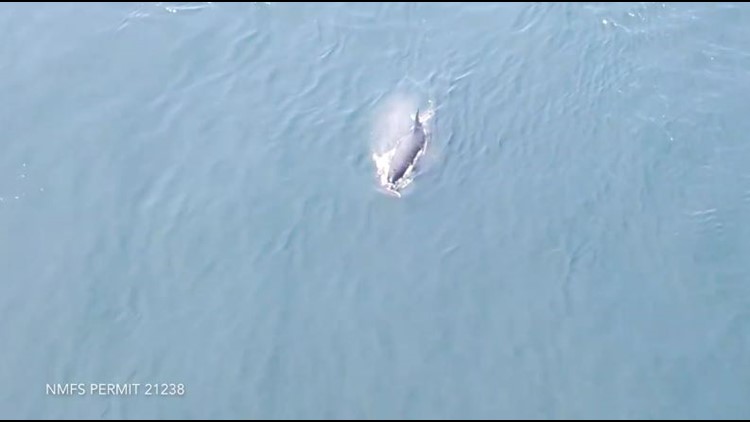Whale researchers are keeping a close watch on the endangered orca that has spent the past week keeping her dead calf afloat in Pacific Northwest waters, a display that has struck an emotional chord around the world and highlighted the plight of the declining population that has not seen a successful birth since 2015.
Researchers have observed the 20-year-old whale known as J35 pushing her dead young along and propping it up while swimming for miles in the waters of Washington state and British Columbia. The calf died July 24 shortly after it was born. Its mother was seen Tuesday night still clinging to the dead calf off British Columbia's Gulf Islands, said Jenny Atkinson, executive director of the Whale Museum on San Juan Island.
Experts say the orca and other family members traveling with her are grieving or mourning. And while it isn't uncommon for whales and dolphins mourn their young, they say, it's unusual that it has been going on for so long.
"There's evidence that cetaceans such as dolphin and whales are often attending to dead bodies. Sometimes, it's because of curiosity or exploration and not necessarily emotion. Other mother dolphins and whales have kept their calves buoyant," said Barbara King, professor emerita of anthropology at the College of William and Mary and author of "How Animals Grieve."
"What's different about J35 is her persistence," she said, but then asked: "How resilient can she be? How long can she keep this up? Is she eating? Is she taking care of herself?"
The orca and her closely knit pod of whales have been observed taking turns carrying the dead calf, Atkinson said. A crew with the museum's Soundwatch boater education program has been spending about 11 hours each day tracking J-35, also called Tahlequah, and making sure boaters give the whales distance.
Researchers have collected poop samples from the group of whales that includes the grieving mother. They are preparing to try and recover the dead calf to understand more about why it died.
Meanwhile, the images of the whale balancing the dead orca have captivated the public and garnered global attention.
"There's an optic that's more powerful than any other statistic. It's a picture of what we can assume is a heartbroken mother who herself is necessary and precious to this population," said Jason Colby, professor of environmental history at the University of Victoria and author of "Orca: How We Came to Know and Love the Ocean's Greatest Predator."
Not long ago, killer whales were shot at and later captured live for marine parks, but "now we're seeing the extraordinary spectacle that is exactly the opposite — the emotional public outpouring and sharing in this mother's grief," he said.
The distinctive black-and-white orcas have struggled since they were listed as an endangered species in the U.S. and Canada over a decade ago. They're not getting enough of the large, fatty Chinook salmon that make up their main diet. They also face overlapping threats from toxic contamination and noise and disturbances from boats that can interfere with their ability to forage or communicate.
Female orcas have been having pregnancy problems because of nutritional stress linked to lack of salmon. A multiyear study last year by University of Washington and other researchers found that two-thirds of the orcas' pregnancies failed between 2007 and 2014.
The dead calf was the first in three years among the fish-eating southern resident killer whales that typically spend spring to fall in the inland waters of Washington state and British Columbia.
There are now only 75 whales, the lowest number in three decades, and researchers are worried about the fate of another 4-year-old female orca known as J-50 that looks thin and emaciated.
The orcas are distinct from other killer whales because they eat salmon, mostly Chinook salmon, which are also declining, rather than marine mammals. Individual whales are identified by unique markings or variations in their fin shapes, and each whale is given a number and name.
Traveling together in matrilineal groups, the orcas at times can be seen breaching around Puget Sound, even against the backdrop of the downtown Seattle skyline.
Deborah Giles, a scientist with the University of Washington's Center for Conservation Biology, has observed the grieving mother whale in recent days. At times the whale dives into the water to retrieve her calf when it sinks, retrieves it and pushes the calf back to the surface.
"Sometimes she's on her own with that calf, but a lot of time, she's with her mom and her son and another relative. Her family has been right by her," Giles said.
Giles said she worries for the mother, who must expend a lot of energy to keep the dead calf afloat.
King, the author, said one reason the story is touching such an emotional chord for people around the world is because it's a poignant example of a mother's behavior with her dead calf that's unusual and it's tied to the decline of her population.
"She's a thinking, feeling animal," King said, "but also in my mind becoming a symbol of what we're doing wrong."
Also see | Orca protection order signed by Inslee



